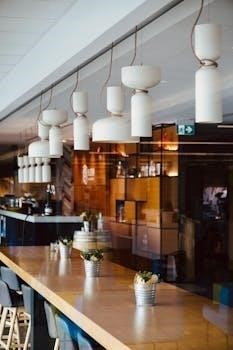Restaurant Menu PDF⁚ A Comprehensive Guide
A well-designed menu enhances the dining experience and reflects your brand. This guide offers restaurant menu ideas to create captivating menus for your business‚ ensuring recognition and success in the food service industry. Explore examples of effective designs.
The Importance of Menu Design
The menu is a vital internal marketing tool‚ essential for any restaurant‘s success. A thoughtfully designed menu enhances the dining experience and reflects your brand identity‚ significantly boosting profits. It informs customers about your offerings and encourages them to explore new dishes. Whether you operate a fine dining establishment‚ a cozy café‚ or a fast-food outlet‚ your menu‘s design profoundly impacts customer experience. Your menu is fundamental to business success‚ and standing out is crucial. It guides customers‚ showcases your offerings‚ and creates an impactful dining experience. Effective design and strategic presentation are key‚ influencing customer choices and boosting revenue. A minimalist aesthetic can complement various businesses‚ from bistros to fast food. Good design principles—readability‚ layout‚ and color scheme—make a memorable dining experience. Your menu is the first impression; enhance it with thoughtful design. Explore examples that highlight effective ways to present dishes and boost profits. Whether planning a new restaurant or updating an existing menu‚ the design matters. A well-crafted menu can elevate your restaurant‘s success and encourage exploration of offerings. The design can significantly impact both fine dining and casual eateries. Inspiration from different restaurants‚ cafés‚ and bars can help. It’s a key tool for showcasing creativity and functionality. Thoughtful design and strategic presentation create a memorable experience. Enhance the dining experience with a well-designed menu.
Menu Design Principles⁚ Readability‚ Layout‚ Color Scheme
Effective menu design hinges on readability‚ layout‚ and color scheme‚ creating a user-friendly experience. Readability ensures customers can easily understand your offerings. Clear fonts and appropriate font sizes are essential‚ avoiding overly decorative or small text. High contrast between text and background improves visibility‚ especially in dimly lit environments. Layout organizes the menu logically‚ guiding customers efficiently. Sections should be clearly divided‚ grouping similar items together‚ such as appetizers‚ entrees‚ and desserts. Strategic placement of high-profit items can influence customer choices. Ample white space prevents clutter‚ making the menu visually appealing and easy to navigate. Color schemes evoke emotions and reflect your brand. Choose colors that align with your restaurant‘s theme. For example‚ warm colors like red and orange stimulate appetite‚ while cool colors like blue create a calming atmosphere. Color can highlight specific items or sections‚ drawing attention to profitable dishes. Consistency in color usage reinforces brand identity and improves visual coherence. Proper use of these principles enhances the customer experience. A well-organized menu encourages exploration and increases order value. The design affects how customers perceive your restaurant and its offerings. Optimize your menu for profitability by strategically highlighting items. Ensure that the design is accessible and appealing to a wide range of customers. Readability‚ layout‚ and color scheme are key to a successful menu.
Menu Examples⁚ Inspiration for Your Design
Explore diverse restaurant menu examples to inspire your design and enhance your dining experience. From fine dining to fast food‚ these examples showcase effective ways to present your dishes and boost profits. Yeah Burger stands out with its vibrant‚ playful design and clear layout‚ using a bright orange theme and cartoonish illustrations. Cataluna presents a sophisticated‚ elegant design perfect for fine dining‚ organized into distinct sections with a minimalist layout. Spin Pizza features a modern‚ clean design‚ showcasing its offerings with bold headings and organized columns. Applebees combines a clear layout with appetizing food images and calorie information. Moos Coffee presents a minimalist design‚ making it easy to choose beverages with a monochrome color scheme. Chick-a-Biddy features a rustic‚ farm-inspired design on brown kraft paper‚ using bold‚ playful fonts. Happy Bowl is colorful and interactive‚ guiding customers through customizing their own bowls with a chalkboard-style design. Eleven Madison Park offers a minimalist‚ elegant fine dining menu‚ paired with carefully selected wines. Roma Nord Bistro features an elegant design‚ highlighting traditional Italian dishes with Italian language and delicate illustrations. Cheesecake Factory presents a comprehensive selection with a straightforward layout and calorie information. Boston Pizza offers an extensive selection of beverages‚ divided into clear sections with detailed descriptions. Wagamama features a vibrant design with high-quality dish images and dietary preference labels. Gather offers a sophisticated selection with vegan‚ gluten-free‚ and spicy options clearly labeled. These examples highlight diverse approaches‚ providing inspiration for creating a memorable dining experience.
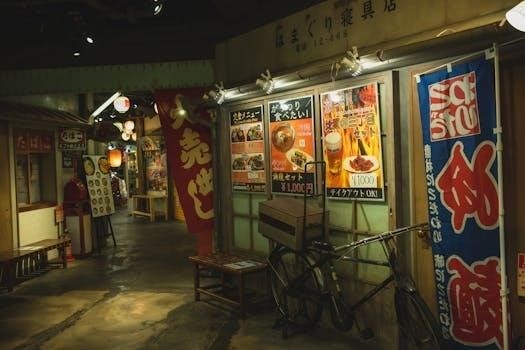
Minimalist Aesthetic Design
A menu with a minimalist aesthetic design can brilliantly complement your business‚ whether you run a bistro‚ fine dining‚ or fast food restaurant. Minimalist menus focus on simplicity and clarity‚ using ample white space‚ clean lines‚ and limited color palettes to create an elegant and uncluttered look. The goal is to present information in a way that is easy to read and visually appealing‚ without overwhelming the customer with excessive details. This design approach often emphasizes high-quality typography and strategic use of imagery to highlight key dishes. By reducing visual noise‚ a minimalist menu allows customers to focus on the core offerings‚ making it easier for them to make a decision. In a fine dining setting‚ this can convey sophistication and attention to detail‚ while in a fast-food context‚ it can streamline the ordering process. Examples of restaurants that effectively use minimalist designs include those that feature a limited number of dishes‚ emphasizing fresh‚ high-quality ingredients. The use of simple icons and clear categorization further enhances the user experience. Ultimately‚ a minimalist aesthetic design aims to create a menu that is both functional and visually pleasing‚ reflecting the restaurant’s brand identity and enhancing the overall dining experience. Consider the Moos Coffee menu‚ which presents a minimalist design for quick beverage selection‚ or the Eleven Madison Park menu‚ which exudes fine dining elegance through simplicity.
Menu a la Carte
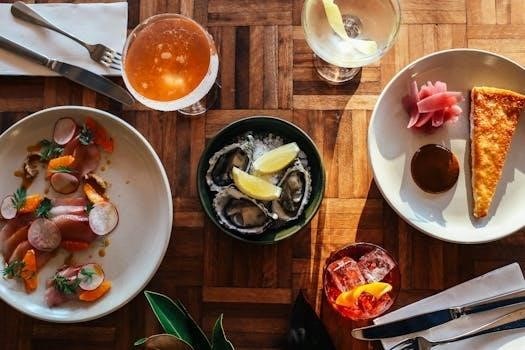
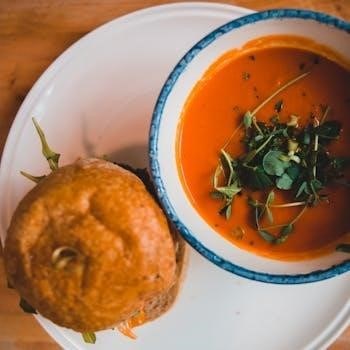
A menu a la carte is a classic menu style that offers a diverse selection of dishes‚ each priced individually‚ allowing diners to customize their meals according to their preferences and budget. This approach provides flexibility‚ enabling customers to choose precisely what they want‚ whether it’s a single appetizer‚ a main course‚ or multiple sides. The a la carte menu is particularly popular in restaurants that offer a wide range of options‚ catering to diverse tastes and dietary needs. The design of an a la carte menu should focus on clear organization and readability‚ making it easy for customers to navigate the extensive list of items. Each dish is typically described with its ingredients and preparation method‚ helping diners make informed choices. The pricing is prominently displayed next to each item‚ ensuring transparency and avoiding any confusion. Effective a la carte menus often group dishes into categories such as appetizers‚ soups‚ salads‚ entrees‚ and desserts‚ making it easier for customers to find what they’re looking for. The layout should be clean and uncluttered‚ with strategic use of whitespace to prevent the menu from feeling overwhelming. Restaurants may also use visual cues‚ such as bold fonts or icons‚ to highlight signature dishes or special offerings. Examples of restaurants that commonly use a la carte menus include fine dining establishments‚ steakhouses‚ and ethnic eateries. The Cataluna menu‚ for example‚ showcases a sophisticated a la carte design with distinct sections for Tapas‚ Garden‚ Sea‚ and Land. Overall‚ the a la carte menu provides a versatile and customer-centric dining experience‚ allowing individuals to create a personalized meal that suits their specific desires.
Digital Menu Examples
Digital menus have become increasingly popular in the restaurant industry‚ offering a modern and interactive way to showcase food and beverage offerings. These menus can take various forms‚ from tablet-based systems to large display screens‚ providing a dynamic and engaging experience for customers. One of the key advantages of digital menus is their flexibility. Restaurants can easily update their menus in real-time‚ adding new items‚ changing prices‚ or highlighting promotions without the need for costly reprints. This is particularly useful for establishments that offer seasonal dishes or daily specials. Digital menus also enhance the customer experience by providing detailed information about each dish‚ including ingredients‚ preparation methods‚ and allergen information. High-quality images and videos can further entice customers‚ showcasing the visual appeal of the food. Many digital menus incorporate interactive elements‚ such as customer reviews‚ nutritional information‚ and the ability to customize orders. These features empower customers to make informed choices and personalize their dining experience. Examples of digital menus can be found in various restaurant settings. Fast-food chains often use digital display screens to showcase their combo meals and promotional offers. Fine dining establishments may opt for tablet-based menus that allow customers to browse through an extensive wine list or view detailed descriptions of each dish. Coffee shops and cafes can use digital menus to highlight their specialty drinks and pastries. The Wagamama menu‚ for example‚ features a vibrant and visually appealing digital design with high-quality images and clear labels for dietary preferences. Overall‚ digital menus offer a versatile and engaging way to enhance the dining experience and streamline restaurant operations.
Menu Design for Different Restaurant Types (Fine Dining‚ Fast Food‚ Cafe)
The design of a restaurant menu should align with the type of establishment and the overall dining experience it aims to provide. Different restaurant types‚ such as fine dining‚ fast food‚ and cafes‚ require distinct approaches to menu design to effectively communicate their offerings and appeal to their target audience. For fine dining restaurants‚ the menu design often emphasizes elegance and sophistication. Minimalist layouts with ample white space‚ refined typography‚ and high-quality paper stock are common choices. The language used in the menu descriptions is typically descriptive and evocative‚ highlighting the premium ingredients and culinary techniques used in each dish. The Cataluna menu is a great example of a sophisticated design that suits a fine dining experience. In contrast‚ fast food restaurants prioritize speed and convenience in their menu design. Clear‚ concise layouts with bold fonts and vibrant colors are used to quickly convey information and encourage impulse purchases. Combo meals and value deals are prominently displayed‚ and images of the food are often used to entice customers. The Wendys drive through menu showcases how fast food establishments use clear divisions and high-quality food images. Cafes typically adopt a more casual and approachable menu design. Chalkboard-style menus‚ handwritten fonts‚ and rustic paper can create a cozy and inviting atmosphere. The menu descriptions tend to be less formal and more conversational‚ reflecting the relaxed ambiance of the cafe. The Moos Coffee menu presents a minimalist design that helps customers quickly find their beverages. The Happy Bowl menu exemplifies a colorful and interactive design suitable for a cafe.
Implementing Online Ordering with Your Menu
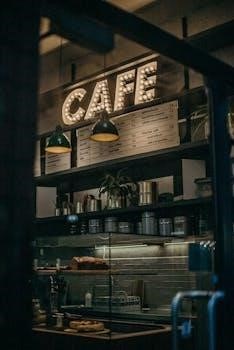
Implementing online ordering is crucial for modern restaurants‚ and your menu plays a central role in this process. A well-designed online menu should be user-friendly‚ visually appealing‚ and optimized for various devices. The key is to ensure that your online menu accurately reflects your physical menu while taking advantage of digital capabilities. Start by ensuring that your online menu is easy to navigate. Organize your offerings into clear categories‚ just as you would in a printed menu. Use high-quality images of your dishes to entice customers and provide accurate descriptions that highlight key ingredients and preparation methods. Make sure the online menu is mobile-friendly‚ as many customers will be accessing it from their smartphones or tablets. Integrate your online ordering system with your point of sale (POS) system to streamline order processing and inventory management. This integration helps to reduce errors and ensures that your online menu is always up-to-date. The Wagamama menu features a visually appealing design with high-quality images‚ making it suitable for online adaptation. Consider offering customization options online‚ allowing customers to modify their orders to their preferences. Clearly display any additional charges for modifications and ensure that the ordering process is intuitive and straightforward. Provide accurate delivery time estimates and order tracking information to enhance the customer experience. Promote your online ordering platform through your website‚ social media channels‚ and email marketing campaigns. Consider offering special promotions or discounts to encourage customers to place their orders online. By carefully planning and executing your online ordering strategy‚ you can increase sales‚ improve customer satisfaction‚ and streamline your restaurant operations.
Free Restaurant Menu Templates
Creating an eye-catching restaurant menu has never been easier‚ thanks to the availability of free restaurant menu templates. These templates provide a convenient and cost-effective way to design professional-looking menus without the need for extensive graphic design skills. Whether you are opening a new restaurant or looking to update your existing menu‚ these templates can save you time and effort. Many online platforms offer a wide variety of free restaurant menu templates that cater to different styles and cuisines. These templates are often customizable‚ allowing you to easily add your own branding‚ images‚ and menu items. Look for templates that are compatible with popular design software such as Adobe Photoshop‚ Illustrator‚ or even user-friendly online tools like Canva. Before selecting a template‚ consider the overall aesthetic and theme of your restaurant. A minimalist template might be suitable for a modern café‚ while a more elaborate design could be appropriate for a fine-dining establishment. Ensure that the template is well-organized and easy to read‚ with clear sections for appetizers‚ entrees‚ desserts‚ and beverages. The Yeah Burger menu‚ with its vibrant and playful design‚ is a good example of a template that can be easily adapted. Pay attention to the color scheme and typography of the template. Choose colors that complement your brand and fonts that are legible and visually appealing. High-quality images of your dishes are essential for enticing customers‚ so make sure the template allows you to showcase your food effectively. Remember to proofread your menu carefully for any errors before printing or publishing it online. By leveraging free restaurant menu templates‚ you can create a professional and attractive menu that enhances the dining experience for your customers.

